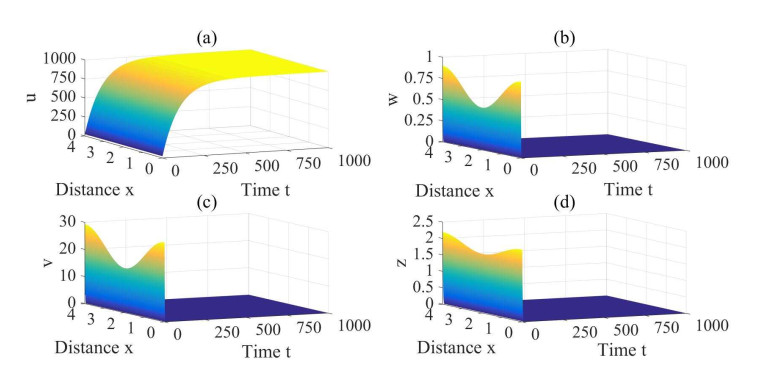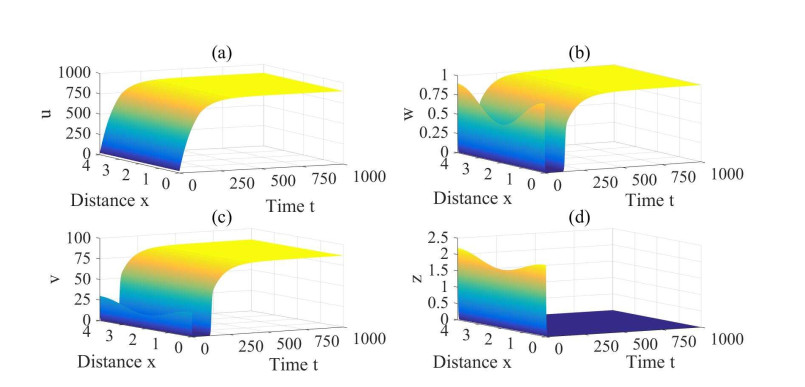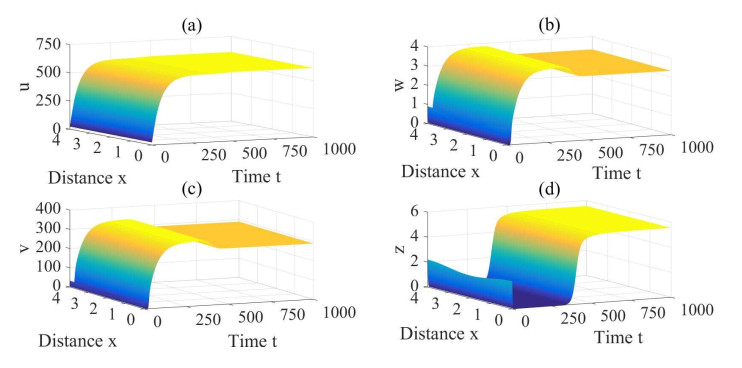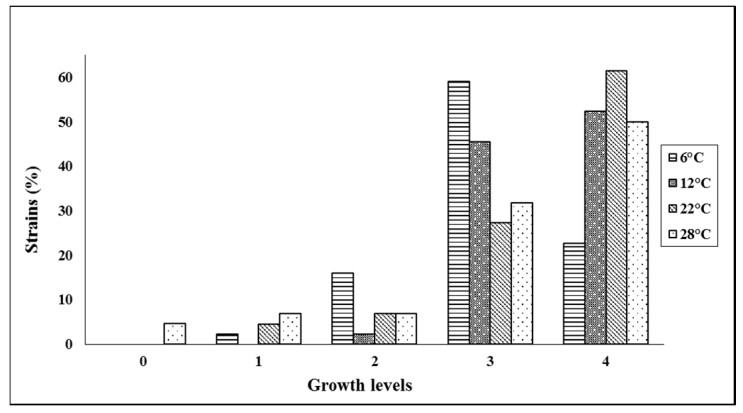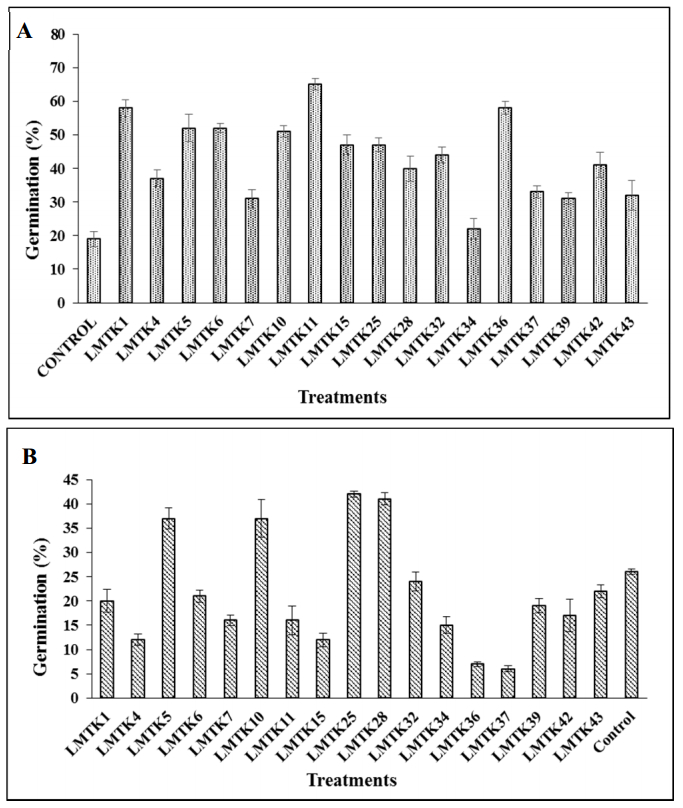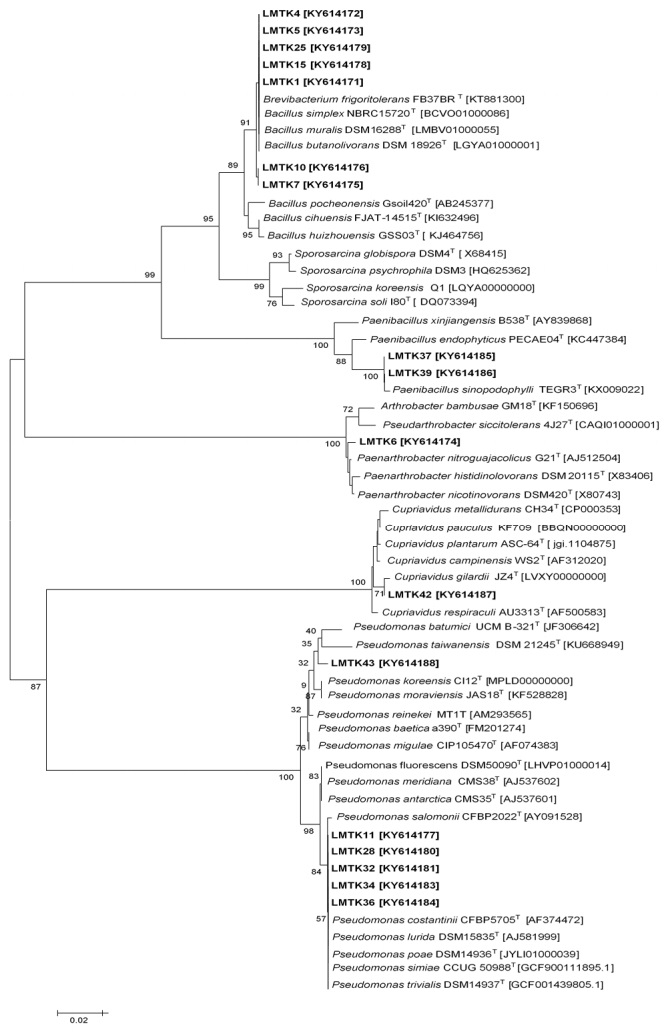The high Andean plateau of Peru is known to suffer harsh environmental conditions. Acidic soils containing high amount of heavy metals due to mining activities and withstanding very low temperatures affect agricultural activities by diminishing crop quality and yield. In this context, plant growth promoting rhizobacteria (PGPR) adapted to low temperatures and tolerant to heavy metals can be considered as an environment-friendly biological alternative for andean crop management. The aim of this work was to select and characterize psychrotrophic PGPR isolated from the rhizosphere of maca (Lepidium meyenii Walp.) a traditional andean food crop. A total of 44 psychrotrophic strains isolated from 3 areas located in the Bombon plateu of Junin-Peru were tested for their PGPR characteristics like indole acetic acid (IAA) production, phosphate solubilization and for their ability to improve seed germination. In addition, their capacity to grow in the presence of heavy metals like cadmium (Cd), lead (Pb), cobalt (Co) and mercury (Hg) was tested. Of the total number of strains tested, 12 were positive for IAA production at 22 °C, 8 at 12 °C and 16 at 6 °C. Phosphate solubilization activities were higher at 12 °C and 6 °C than at 22 °C. Red clover plant assays showed that 16 strains were capable to improve seed germination at 22 °C and 4 at 12 °C. Moreover, 11 strains showed tolerance to Cd and Pb at varying concentrations. This study highlight the importance of obtaining PGPRs to be used in high andean plateu crops that are exposed to low temperatures and presence of heavy metals on soil.
1.
Introduction
Viral dynamics is a field of applied mathematics which employs mathematical models to describe the changes over time of infected cells and the viral load. Nowak et al. [1] and Nowak and May [2] proposed the following basic viral dynamic model,
where u(t), w(t), and v(t) are the numbers of uninfected cells, productively infected cells, and virus particles at time t, respectively. See the references for the biological meanings of the parameters. This basic model has been modified to study different viral infections, which include hepatitis C virus (HCV) [3,4], human immunodeficiency virus (HIV) [5,6,7,8], human T-cell leukemia virus (HTLV) [9,10,11], and so on.
During the process of viral infection, specific immune response plays an important role. Specific immune response includes cell-mediated immunity (which depends on cytotoxic T lymphocytes response (CTLs)) and humoral immunity (which depends on antibody response). Since the work of Nowak and Bangham [12], much has been done on mathematical models on immune response against infected cells [13,14,15,16].
Nowadays, time delays have been taken into account in order to better understand viral dynamics. Usually, distributed time delays [17,18,19] and discrete time delays [20,21,22] have been incorporated into viral dynamic models. In particular, based on (1.1), Zhu and Zou [20] proposed the following viral dynamic model with time delay and CTL immune response,
where z(t) denotes the density of immune effectors at time t. Here the delay ˆτ represents the time from a virus entering a target cell to the production of new free virus particles. We refer to [20] for the meanings of the other parameters.
Note that both models (1.1) and (1.2) and most existing ones are described by ordinary differential equations. The cells and free virus particles are assumed to be uniform in location. In other words, the effect of spatial heterogeneity is ignored. For example, the lymphoid tissues are among the primary sites of HIV infection and replication. The lymphoid tissues consist of many lymph nodes with different sizes. The different tissue architecture and composition and biophysical parameters can influence the spread and replication of the virus [23]. To understand the viral pathogenesis better, it is necessary to consider the spatial aspects of the tissues. In [24], Wang and Wang proposed the following mathematical model of HBV infection with spatial dependence,
where u(x,t), w(x,t), and v(x,t) are the densities of uninfected cells, productively infected cells, and free virus particles at spatial position x and time t, respectively. D is the diffusion coefficient and Δ is the Laplace operator. Using the geometric singular perturbation method, they studied the existence of traveling waves. Since then a lot of works have followed in this direction (see, for example, [25,26,27,28,29]).
In (1.1), (1.2), and (1.3), only the cell-free transmission (newly released free virus particles infect uninfected cells [2]) is considered. Recent experimental studies [30,31] prove that a healthy cell can be infected when it comes with close contact of an infected cell (cell-to-cell transmission [32,33]). Sigal et al. [34] found that the cell-to-cell spread of HIV can still permit ongoing replication even with an antiretroviral therapy. Consequently, viral dynamic models incorporating both transmission modes have been formulated and studied (to name a few, see [35,36,37,38,39]). We should mention that the incidences in these works are bilinear. Incidence is the number of new infections per unit of time. It depends on the infectivity of viruses and behavior of cells. Thus it is reasonable to be nonlinear in general. For example, the saturated incidence rate βuv1+αv is used in [40] and the Beddington-DeAngelis incidence function is used in [41]. In a recent work, Sun and Wang [42] also used a general incidence f(u,v) in a diffusive viral dynamic model.
Based on the above discussion, in this paper, we propose and study the following delayed diffusive viral dynamic model with cell-mediated immunity, cell-to-cell transmission, and general incidences,
where z(x,t) denotes the densities of immune effectors at spatial position x and time t. Ω is a general open bounded domain in Rn with smooth boundary ∂Ω. We consider model (1.4) with the homogeneous Neumann boundary conditions
where ∂∂→n denotes the outward normal derivative on ∂Ω. We also assume the initial conditions
where ϕi's (i=1, 2, 3, 4) are bounded and uniformly continuous functions on ¯Ω×[−τ,0].
In (1.4), intracellular delays for both transmission modes are assumed to be the same. In general, the intracellular delay in the cell-to-cell transmission is less than that in the cell-free infection [30,39]. However, the difference is not large enough. As for some existing studies (for example, [35,38]), for simplicity of presentation, we make the above assumption on the delays.
In (1.4), the incidences due to the cell-free transmission and the cell-to-cell transmission are given by the nonlinear functions f(u,v) and g(u,w), respectively. As in [26], we always make the following assumption on them in the sequel.
(A1) The nonlinear incidence functions f and g satisfy the following properties.
(i) f(u,v)≥0 and g(u,w)≥0 for u≥0, v≥0, and w≥0, and the equalities hold if and only if uv=0 and uw=0;
(ii) There exists η1>0 and η2>0 such that f(u,v)≤η1u and g(u,w)≤η2u for u≥0, v≥0, and w≥0;
(iii) ∂f(u,v)∂u and ∂g(u,w)∂u are continuous with ∂f(u,v)∂u>0 and ∂g(u,w)∂u>0 for u≥0, v>0, and w>0;
(iv) ∂f(u,v)∂v and ∂g(u,w)∂w are continuous with ∂f(u,v)∂v≥0 and ∂g(u,w)∂w≥0 for u≥0, v≥0, and w≥0;
(v) v∂f(u,v)∂v−f(u,v)≤0 and w∂g(u,w)∂w−g(u,w)≤0 for u≥0, v≥0, and w≥0.
Note that, by Assumption (A1), for any u>0,
which implies that f(u,v)v is decreasing on (0,∞). In particular, for any u>0 and v>0,
An analog also holds for g. Thus we have
The rest of the paper is organized as follows. In section 2, we consider the existence, uniqueness, positivity, and boundedness of solutions to system (1.4)–(1.6). Then we study the existence of homogeneous steady states in section 3, which depend on the basic reproduction number of infection and the basic reproduction number of immunity. The main part is section 4, where we discuss the local and global dynamics of system (1.4)–(1.6) by analyzing the characteristic equations and constructing suitable Lyapunov functionals. These results are supported with numerical simulations in section 5. The paper ends with a brief conclusion.
2.
Well-posedness
Let X:=C(¯Ω,R4) be the Banach space equipped with the supremum norm ‖⋅‖X. For τ≥0, define C=C([−τ,0],X), which is a Banach space equipped with the norm ‖ϕ‖=maxθ∈[−τ,0]‖ϕ(θ)‖X. If σ>0 and U:[−τ,σ)→X, then for t∈[0,σ), Ut∈C is defined by Ut(θ)=U(t+θ) for θ∈[−τ,0]. Denote X+=C(¯Ω,R4+) and C+=C([−τ,0],X+). Then both (X,X+) and (C,C+) are strongly ordered spaces. According to Corollary 4 in [43], we have the following result on the well-posedness. The arguments are standard and hence are omitted here. Interested readers can refer to, for example, a recent paper by Gao and Wang [44].
Theorem 2.1. For each ϕ=(ϕ1,ϕ2,ϕ3,ϕ4)∈C+, system (1.4)–(1.6) has a unique solution U(⋅,t,ϕ)=(u(⋅,t,ϕ),w(⋅,t,ϕ),v(⋅,t,ϕ),z(⋅,t,ϕ)) on [0,∞) with U0(⋅,ϕ)=ϕ. Moreover, Ut(⋅,ϕ)∈C+ for t≥0 and U(⋅,t,ϕ) is a classical solution.
Let Φ(t):C+→C+ be the solution semiflow associated with (1.4)–(1.6), that is, Φ(t,ϕ)=Ut(⋅,ϕ), where U(⋅,t,ϕ) is the solution of (1.4)–(1.6) with the initial condition ϕ∈C+.
The following result gives some properties of solutions.
Lemma 2.2. For ϕ∈C+, the following statements hold for the solution U(⋅,t,ϕ) of (1.4)–(1.6).
(i) lim supt→∞u(x,t,ϕ)≤sd, lim supt→∞w(x,t,ϕ)≤e−mτ(η1+η2)sdδ, lim supt→∞v(x,t,ϕ)≤Ne−mτ(η1+η2)sdc, and lim supt→∞z(x,t,ϕ)≤e−mτ(η1+η2)sdmin{δ,b} uniformly for all x∈Ω.
(ii) u(⋅,t,ϕ)>0 for t>0 and lim inft→∞u(x,t,ϕ)≥sd+η1+η2 uniformly for all x∈Ω.
(iii) If w(⋅,t0,ϕ)≢0 or v(⋅,t0,ϕ)≢0 for some t0≥0, then w(x,t,ϕ)>0 and v(x,t,ϕ)>0 for all x∈Ω and t>t0+τ.
(iv) If z(⋅,t0,ϕ)≢0 for some t0≥0, then z(x,t,ϕ)>0 for all x∈Ω and t>t0.
Proof. For simplicity of notation, in the proof here we omit ϕ from the expressions of the solution.
(ⅰ) First, we have
which implies that lim supt→∞u(x,t)≤sd uniformly for all x∈Ω. Next, by Assumption (A1) and the second equation in (1.4), we have
Then lim supt→∞w(x,t)≤e−mτ(η1+η2)sdδ uniformly for x∈Ω follows easily from this and lim supt→∞u(x,t)≤sd uniformly for x∈Ω. Similarly, adding the second and fourth equations of (1.4) yields
It follows that lim supt→∞(w(x,t)+z(x,t))≤e−mτ(η1+η2)sdmin{δ,b} uniformly for x∈Ω and hence lim supt→∞z(x,t)≤e−mτ(η1+η2)sdmin{δ,b} uniformly for x∈Ω. Now, lim supt→∞w(x,t)≤e−mτ(η1+η2)sdδ uniformly for x∈Ω together with the third equation of (1.4) (Lemma 1 in [45]), and comparison theorem, gives lim supt→∞v(x,t)≤Ne−mτ(η1+η2)sdc uniformly for x∈Ω.
(ⅱ) Noting that ∂u(x,t)∂t≥s−(d+η1+η2)u(x,t), one can easily get
for x∈Ω and t≥0. Then (ⅱ) follows immediately.
(ⅲ) Note that the operator D1Δ−cId generates a positive semigroup on C(¯Ω,R), where Id is the identity operator. Thus if w(⋅,t0)≢0, then from the third equation of (1.4), we see that v(⋅,t)≢0 for t>t0. Without loss of generality, we assume that v(⋅,t0)≢0. We first show that v(⋅,t)>0 for t>t0. By Theorem 2.1, v(x,t) satisfies
Let ˉv(x,t) be the solution of
Then ˉv(x,t)>0 for x∈Ω and t>t0. In fact, suppose, by contradiction, there exist x0∈Ω and ˆt>t0 such that ˉv(x0,ˆt)=0. Then, according to the strong maximum principle [46], ˉv(x,t)≡0 for each t≥t0, contradicting with ˉv(⋅,t0)≢0. Applying the comparison theorem, we know that v(x,t)≥ˉv(x,t)>0 for t>t0 and x∈Ω. We now prove that w(x,t)>0 for x∈Ω and t>t0+τ. Otherwise, there exist ˉx∈Ω and ˉt>t0+τ such that w(ˉx,ˉt)=0. As w(x,t)≥0, we have ∂w(ˉx,ˉt)∂t=0. This is impossible since
by Assumption (A1) (ⅱ) due to u(ˉx,ˉt−τ)>0 and v(ˉx,ˉt−τ)>0. This proves statement (ⅲ).
(ⅳ) The proof is similar to that of (ⅲ) on v(x,t)>0 for x∈Ω and t>t0 and hence we omit it here. This completes the proof.
Lemma 2.2 tells us that Φ is point dissipative. Then it follows from Theorem 2.1.8 in [47] that Φ(t) is compact for all t>τ. This, together with Theorem 3.4.8 in [48], gives the following result.
Theorem 2.3. The semiflow Φ has a global compact attractor A in C+. Moreover, u(x,t,ϕ)≤sd for all x∈¯Ω, t≥0, and ϕ∈A.
3.
Steady states and basic reproduction numbers
System (1.4) with (1.5) always has a unique infection-free steady state P0=(u0,0,0,0), where u0=s/d. Applying the result of Wang and Zhao (Theorem 3.4 in [49]), we can obtain the expression of the basic reproduction number of infection, R0, which is given by
Denote
Then R01 is the number of secondly infected cells through the cell-free transmission and it is referred to as the basic reproduction number from the cell-free transmission; while R02 is the number of secondly infected cells through the cell-to-cell transmission and it is referred to as the basic reproduction number from the cell-to-cell transmission [38].
In the following, we discuss the existence of homogeneous steady states for (1.4) (the stability results in section 4 indicate that they are the only possible steady states). Clearly, a homogeneous steady state P=(u,w,v,z) satisfies
It follows from (3.1d) that z=0 (which corresponds to the immunity-free infected steady states) or w=bq (which, when z≠0, corresponds to the infected-immune steady states).
We firstly consider the case where z=0. It follows from (3.1c) that v=Nδwc. Multiplying both sides of (3.1b) by emτ and then adding up the resultant and (3.1a) to get u=s−δwemτd. It is necessary that w∈(0,sδemτ). Substituting u=s−δwemτd and v=Nδwc into (3.1a), we see that w is a positive zero of H1, where
According to Assumption (A1), we have H1(0)=0, H1(sδemτ)−s<0, and
If R0>1, then H′1(0)>0. This, together with H1(0)=0, implies that H1(w) is positive for all sufficiently small w>0. By the Intermediate Value Theorem, H1 has at least one zero in (0,sδemτ) and hence (1.4) has at least one immunity-free infected steady state. In fact, there is only one such steady state by the claim that H′1(w1)<0 for any immunity-free infected steady state, which is proved as follows. Note that δemτ=f(u1,v1)w1+g(u1,w1)w1 and w1=cv1Nδ. By Assumption (A1),
This proves the claim. Next, we assume that R0<1. Then H′1(0)=δemτ(R0−1)<0, which combined with H1(0)=0 implies that H1(w)<0 for w>0 sufficiently small. Using the above claim, we can easily see that there is no immunity-free infected steady state when R0<1. Moreover, H1(w)<0 for w∈(0,sδemτ]. Finally, we assume that R0=1. We use contradictive arguments to show that there is no immunity-free infected steady state in this case. Otherwise, assume that H1(w) has a positive zero say w∗. Then from the above claim H1(w)>0 for w<w∗ and closely enough to w∗. Note that H1(w) depends continuously on the parameters and H1(w)<0 for w∈(0,sδemτ] when R0<1. Fix w∈(0,w∗). Choose a sequence of parameters such that the basic reproduction number R0<1 and tends to 1. Then H1(w) tends to H1(w∗)>0, a contradiction to the fact that the limit is less than or equal to 0. This proves that there is no immunity-free infected steady state when R0=1.
Now we study the case where w=bq. This, together with (3.1c), yields v=Nδbcq. As before, add up (3.1a) and (3.1b) multiplied by emτ to get z=s−du−δemτwpemτw, which necessarily requires u∈(0,sd−δbdqemτ). Substituting w=bq and z=s−du−δemτwpemτw into (3.1a), we see that u is a positive zero of H2, where
With Assumption (A1), we have H2(0)=−s<0 and
Therefore, in order for model (1.4) to have an infected-immune steady state (if exists there is a unique one), it is necessary and sufficient that H2(sd−δbdqemτ)=H1(bq)>0. Recall that when R0≤1, H1(w)<0 for w∈(0,sδemτ]; while when R0>1, H1(w)>0 for w∈(0,w1) and H1(w)<0 for w∈(w1,sδemτ). It follows that H1(bq)>0 if and only if R0>1 and bq<w1. Denote,
As q is the average number of immune effectors produced from contacting with a productively infected cell and 1b is the average life of an immune effector, it follows that R1 is the total number of immune effectors produced at the immunity-free infected steady state. Thus R1 is called the basic reproduction number of immunity.
Summarizing the above discussion, we have obtained the following result on the existence of homogeneous steady states.
Theorem 3.1. For model (1.4) with (1.5), the following statements on the existence of homogeneous steady states are true.
(i) If R0≤1, then there is only the infection-free steady state P0.
(ii) If R1≤1<R0, then besides P0, there is also a unique immunity-free infected steady state P1=(u1,w1,v1,0), where w1 is the only positive zero of H1 defined by (3.2), u1=s−δw1emτd and v1=Nδw1c.
(iii) If R1>1 (it is necessary that R0>1), then in addition to P0 and P1, there is also a unique infected-immune steady state P2=(u2,w2,v2,z2), where u2 is the only positive zero of H2 defined by (3.3), w2=bq, v2=Nδbcq, and z2=s−du2−δw2emτpw2emτ.
4.
Stability analysis
In the main part of this paper, we establish the stability of each steady state obtained in Theorem 3.1.
Let P∗=(u∗,w∗,v∗,z∗) be an arbitrary homogeneous steady state. The linearization of (1.4) at P∗ is
where
Denote 0=μ0<μ1<μ2<⋯<μn<⋯ to be all the eigenvalues of the operator −Δ on Ω with the homogeneous Neumann boundary condition. Then P∗ is locally asymptotically stable if, for any i∈N={0,1,2,…}, every solution of the characteristic equation
has a negative real part and P∗ is unstable if there exists i0∈N such that (4.2) has a solution with a positive real part.
4.1. Stability of the infection-free steady state P0
We first study the local stability of P0.
Proposition 4.1. The infection-free steady state P0 of (1.4) is locally asymptotically stable if R0<1 and unstable if R0>1.
Proof. By (4.2), the characteristic equation at P0 is
Obviously, the stability of P0 is determined by
Firstly, suppose that R0<1. We claim that all roots of (4.3) have negative real parts. Otherwise, there exists i0∈N such that (4.3) has a root λ0 with Re(λ0)≥0. Then
It follows that
a contradiction to R0<1. This proves the claim and hence P0 is locally asymptotically stable when R0<1.
Secondly, assume R0>1. For i∈N, denote
Recall that μ0=0. We have
and
By the Intermediate Value Theorem, F(λ,0) has a positive zero and hence (4.3) has at least one positive zero for i=0. This means that P0 is unstable when R0>1.
In fact, P0 is globally stable if it is locally stable.
Theorem 4.2. If R0≤1, then the infection-free steady state P0 of (1.4) is globally attractive. In particular, P0 is globally asymptotically stable when R0<1.
Proof. It suffices to show that P0 is globally attractive in A. For this purpose, we consider the Lyapunov functional
Calculating the time derivative of W(t) along solutions of model (1.4), we have
It follows from the homogeneous Neumann boundary condition (1.5) and the Divergence Theorem that
Moreover, by Theorem 2.3, u(x,t)≤sd for x∈Ω and t≥0. With the help of (1.7), for v(x,t)>0, we have
The above inequality holds automatically for v(x,t)=0 and also observe that the inequality is strict for u(x,t)<sd and v(x,t)>0. Therefore,
Moreover, dW(t)dt=0 if and only if v(x,t)=0 and z(x,t)=0. In fact, if v(x0,t0)≠0, then there exists a neighborhood N(x0,t0) of (x0,t0) such that v(x,t)≠0 for (x,t)∈N(x0,t0). Then by the observation, u(x,t)=sd for (x,t)∈N(x0,t0). This, together with the first equation of (1.4) and Assumption (A1), implies that v(x,t)=0 for (x,t)∈N(x0,t0), a contradiction. Then it is easy to see that the largest invariant subset of dW(t)dt=0 is {P0}. By LaSalle's Invariance Principle (see Theorem 5.3.1 in [50] or Theorem 3.4.7 in [51]), the infection-free steady state P0 is globally attractive. In particular, this together with Proposition 4.1, tells us that P0 is globally asymptotically stable when R0<1.
4.2. Stability of the immunity-free infected steady state P1
Next we consider the stability of the immunity-free infected steady state P1. For convenience of notations, denote
Theorem 4.3. Suppose R0>1. Then the immunity-free infected steady state P1 of (1.4) is locally asymptotically stable if R1<1 and unstable if R1>1.
Proof. From (4.2), we know that the characteristic equation at P1 is given by
where
Clearly, the eigenvalue λ=b(R1−1)−μiD2<0 for i∈N when R1<1 but when R1>1, with i=0, we have a positive eigenvalue λ=b(R1−1). Thus P1 is unstable if R1>1. Now, we assume that R1<1. Then the stability of P1 is determined by the roots of ρi(λ)=0, which is equivalent to
We claim that all solutions of (4.4) have negative real parts. Otherwise, suppose that there exists i1∈N such that (4.4) has a solution λ1 with Re(λ1)≥0. Then
However, from the steady state Eqs (3.1b) and (3.1c), we have
This and Assumption (A1) (v) together give us
which is a contradiction with (4.5). This proves the claim and hence P1 is locally asymptotically stable when R1<1<R0.
Before studying the global stability of P1, we establish the persistence of infection.
From the linearized system at P0 (see (4.1)), we have the following cooperative system for (w,v),
With similar arguments as those for Lemma 3 and Lemma 4 in Lou and Zhao [45], we can obtain the following results.
Lemma 4.4. There exists a principal eigenvalue ˉλ(u0,τ)≜ˉλ(P0,τ) of (4.6) associated with a strongly positive eigenvector. Moreover, ˉλ(u0,τ) has the same sign as λ(u0)≜ˉλ(u0,0).
Lemma 4.5. R0−1 and λ(u0) have the same sign.
Theorem 4.6. Suppose R1≤1<R0. Then the infection is persistent, that is, there exists ε>0 such that
uniformly for all x∈¯Ω, where ϕ∈W1:={ϕ∈C+:w(⋅,0)≢0 and v(⋅,0)≢0}.
Proof. Define
By Lemma 2.2 and the second equation of (1.4), we know that Φ(t)W1⊆W1 for all t≥0. Denote
Claim 1. ω(ϕ)={(u0,0,0,0)} for ϕ∈M∂, where ω(ϕ) is the omega limit set of the orbit O+(ϕ):={Φ(t)ϕ:t≥0}.
Since ϕ∈M∂, for all t≥0, either w(x,t,ϕ)≡0 or v(x,t,ϕ)≡0. If w(x,t,ϕ)≡0 for all t≥0, then limt→∞v(x,t,ϕ)=0 uniformly for x∈¯Ω from the third equation of (1.4). Now, suppose that w(x,t1,ϕ)≢0 for some t1≥0. Then by Lemma 2.2, w(x,t,ϕ)>0 for all t≥t1+τ and x∈Ω. Thus v(x,t,ϕ)≡0 for all t≥t1+τ. This, combined with the third equation of (1.4), implies that w(x,t,ϕ)≡0 for x∈¯Ω and t≥t1+τ. Then, in either case, limt→∞v(x,t,ϕ)=limt→∞w(x,t,ϕ)=0 uniformly for x∈¯Ω. Thus u is asymptotic to
By Corollary 4.3 in [52], we get limt→∞u(x,t,ϕ)=u0 uniformly for x∈¯Ω. The above discussion tells us that w(x,t,ϕ)≡0 for all t large enough. Then we can easily see from the fourth equation of (1.4) that limt→∞z(x,t,ϕ)=0 uniformly for x∈¯Ω. This proves ω(ϕ)={(u0,0,0,0)}.
Since R1≤1<R0, by Lemma 4.4 and Lemma 4.5, there exists a sufficiently small ε0>0 such that the following linear system
has a positive principal eigenvalue ˉλ(u0−ε0) with positive eigenfunction (wε0,vε0). By the continuity in Assumption (A1), there exists δ0∈(0,ε0] such that
for all u0−δ0≤u≤u0+δ0, 0≤v≤δ0, and 0≤w≤δ0.
Claim 2. {(u0,0,0,0)} is a uniform weak repeller for W1 in the sense that
Suppose, by contradiction, there exists ϕ∗1∈W1 such that lim supt→∞‖Φ(t)ϕ∗1−(u0,0,0,0)‖<δ0. Then there exists t2>0 such that u(x,t,ϕ∗1)>u0−δ0≥u0−ε0, w(x,t,ϕ∗1)≤δ0, and v(x,t,ϕ∗1)≤δ0 for t≥t2 and x∈¯Ω. It follows from Assumption (A1) and the choice of δ0 that w and v satisfy
Due to w(x, t, \phi_1^*) > 0 and v(x, t, \phi_1^*) > 0 for t > 0 and x\in \Omega , there exists \kappa_1 > 0 such that (w(x, t_2+\theta, \phi_1^*), v(x, t_2+\theta, \phi_1^*))\ge \kappa_1 e^{\bar{\lambda}(u_0-\varepsilon_0)(t_2+\theta)}(w_{\varepsilon_0}(x), v_{\varepsilon_0}(x)) for all x\in \Omega and \theta\in [-\tau, 0] . Then it follows from the comparison principle that w(x, t, \phi_1^*)\ge \kappa_1 e^{\bar{\lambda}(u_0-\varepsilon_0)t}w_{\varepsilon_0}(x) and v(x, t, \phi_1^*)\ge \kappa_1 e^{\bar{\lambda}(u_0-\varepsilon_0)t}v_{\varepsilon_0}(x) for all x\in \Omega and t\ge t_2 , a contradiction to the fact that both w(x, t, \phi_1^*) and v(x, t, \phi_1^*) are bounded. This proves Claim 2.
Define a continuous function \mathcal{P}_1 : \mathcal{C}^+\rightarrow[0, \infty) by
Clearly, \mathcal{P}_1^{-1}(0, \infty)\subset\mathcal{W}_1 , and \mathcal{P}_1 has the property that if \mathcal{P}_1(\phi) = 0 and \phi\in\mathcal{W}_1 or \mathcal{P}_1(\phi) > 0 , then \mathcal{P}_1(\Phi(t)\phi) > 0 for all t > 0 . Hence, \mathcal{P}_1 is a generalized distance function for the semiflow \Phi(t) [53]. According to the above discussions, we obtain that any forward orbit of \Phi(t) in \mathcal{M}_{\partial} converges to (u_0, 0, 0, 0) , which is isolated in \mathcal{C}^+ and \mathcal{W}^s(u_0, 0, 0, 0)\cap \mathcal{W}_1 = \varnothing , where \mathcal{W}^s(u_0, 0, 0, 0) is the stable manifold of (u_0, 0, 0, 0) . Moreover, there is no cycle in \partial\mathcal{W}_1 from (u_0, 0, 0, 0) to (u_0, 0, 0, 0) . Applying Theorem 3 in [53], we know that there exists an \bar{\varepsilon} > 0 such that \min\{\mathcal{P}_1(\phi)\} > \bar{\varepsilon} for any \phi\in\mathcal{W}_1 . It follows that
This combined with Lemma 2.2 finishes the proof with \varepsilon = \min\{\bar{\varepsilon}, \frac{s}{d+\eta_1+\eta_2}\} .
In order to study the global stability of P_1 , define G:(0, \infty)\ni x\to x-1-\ln x . Obviously, G(x) > 0 for x\in (0, \infty) and G attains its global minimum only at x = 1 . We also need the following assumption.
\bf(A2) The nonlinear incidence functions f(u, v) and g(u, w) satisfy the following conditions.
{\rm (i)} For any u > 0 ,
{\rm (ii)} For any u > 0 ,
Theorem 4.7. Suppose that R_1\leq1 < R_0 and Assumption (A2) are satisfied. Then the immunity-free infected steady state P_1 is globally attractive in
In particular, it is globally asymptotically stable in \mathcal{C}_1^+ if further R_1 < 1 .
Proof. According to Lemma 2.2 and Theorem 4.6, we know that there exists \varepsilon > 0 such that \liminf\limits_{t\to\infty}u(x, t, \phi)\geq\varepsilon , \liminf\limits_{t\to\infty}w(x, t, \phi)\geq\varepsilon , and \liminf\limits_{t\to\infty}v(x, t, \phi)\geq\varepsilon for \phi\in\mathcal{C}_1^+ . Without loss of generality, we define a Lyapunov functional
where
Calculating the time derivative of L(x, t) along solutions of (1.4) yields
With
we have
Clearly,
and
Using the Divergence Theorem and the homogeneous Neumann boundary conditions of (1.5), we have
and
The latter gives
and hence
To summarize, we have obtained
Note that the monotonicity of G(x) on each side of x = 1 and Assumption (A2) give us
Thus
Moreover, \frac{\mathrm {d} L(t)}{\mathrm {d} t} = 0 if and only if u(x, t) = u_1 , w(x, t) = w_1 , v(x, t) = v_1 , and z(x, t) = 0 . Then the largest invariant subset of \frac{\mathrm{d} L(t)}{\mathrm {d} t} = 0 is \{P_1\} . By LaSalle's Invariance Principle (see Theorem 5.3.1 in [50] or Theorem 3.4.7 in [51]), the immunity-free infected steady state P_1 is globally attractive in \mathcal{C}_1^+ when R_1\leq1 < R_0 . This, together with Theorem 4.3, implies that P_1 is globally asymptotically stable in \mathcal{C}_1^+ if further R_1 < 1 .
4.3. The stability of the infected-immune steady state P_2
For convenience of notations, denote
Theorem 4.8. If R_1 > 1 , then the infected-immune steady state P_2 is locally asymptotically stable.
Proof. According to (4.2), the characteristic equation at P_2 is
We claim that all roots of (4.8) have negative real parts. Otherwise, suppose for some i_2\in \mathbb{N} , it has a root \lambda_2 with \mathrm {Re}(\lambda_2)\ge 0 . Since w_2 = \frac {b}{q} , we have
which implies
With similar arguments as those in the proof of Theorem 4.3, we can obtain
Thus we have arrived at
which is impossible as one can check that |(\lambda_2+\mu_{i_2}D_2)(\lambda_2+\delta+pz_2)+pbz_2| > |(\lambda_2+\mu_{i_2}D_2)(\delta+pz_2)| .
This completes the proof.
To establish the global stability of P_2 , we need the persistence of immunity.
From the linearized system at P_1 (see (4.1)), we have the following cooperative system for (w, v, z) ,
With similar arguments as those for Lemma 3 and Lemma 4 in Lou and Zhao [45], we can obtain the following results.
Lemma 4.9. There exists a principal eigenvalue \hat{\lambda}(P_1, \tau) of (4.9) associated with a strongly positive eigenvector. Moreover, \hat{\lambda}(P_1, \tau) has the same sign as \hat{\lambda}(P_1, 0) .
Lemma 4.10. R_1-1 and \hat{\lambda}(P_1, 0) have the same sign.
Theorem 4.11. Suppose that R_1 > 1 (it is necessary that R_0 > 1 ) and (A2) holds. Then the immunity is persistent, that is, there exists \epsilon > 0 such that
uniformly for all x\in\overline{\Omega} , where \phi\in \mathcal{W}_2: = \left\{\phi\in\mathcal{C}^+ : w(\cdot, 0)\not\equiv0, \ v(\cdot, 0)\not\equiv0, \ { and}\ z(\cdot, 0)\not\equiv0 \right\} .
Proof. The proof is quite similar to that of Theorem 4.6. Denote
Set M_0 = \{P_0\} and M_1 = \{P_1\} .
According to Lemma 2.2, we know that w(x, t, \phi) > 0 , v(x, t, \phi) > 0 , and z(x, t, \phi) > 0 for all t > 0 and x\in\Omega , \phi\in\mathcal{W}_2 , which implies that \Phi(t)\mathcal{W}_2\subseteq\mathcal{W}_2 for all t\geq0 . Define
Claim 3. Let \phi\in \mathcal{M}^*_{\partial} . Then \omega(\phi) = M_0 or M_1 .
Sine \phi\in \mathcal{M}^*_{\partial} , for any t\ge 0 , we have either w(x, t, \phi) \equiv 0 , or v(x, t, \phi)\equiv 0 , or z(x, t, \phi)\equiv 0 . If z(x, t_4, \phi)\not\equiv0 for some t_4\ge 0 , then by Lemma 2.2, z(x, t, \phi) > 0 for t > t_4 and x\in \Omega . Then either w(x, t, \phi)\equiv0 or v(x, t, \phi)\equiv 0 for each t > t_4 . By the proof of Claim 1, we know that \omega(\phi) = M_0 . Now, suppose that z(x, t, \phi)\equiv 0 for all t\ge 0 . If for each t\ge 0 , either w(x, t, \phi)\equiv0 or v(x, t, \phi)\equiv 0 , then by Claim 1, \omega(\phi) = M_0 . If there exists \tilde{t}\ge 0 such that w(x, \tilde{t}, \phi)\not \equiv 0 and v(x, \tilde{t}, \phi)\not\equiv 0 . Then by Theorem 4.6, there exists \xi > 0 such that
Now consider the reduced system of (1.4) with z = 0 . Modifying the Lyapunov functional L(t) in the proof of Theorem 4.7 by ignoring the term \frac{p}{q}e^{m\tau}z(x, t) in L(x, t) , we can show that the solution of the reduced system converges to (u_1, w_1, v_1) and hence \omega(\phi) = M_1 . This proves Claim 3.
Claim 4. Both M_0 and M_1 are uniform weak repellers for \mathcal{W}_2 . Since \mathcal{W}_2\subset \mathcal{W}_1 , by Claim 2, M_0 is a uniform repeller for \mathcal{W}_2 . The proof of M_1 being a uniform repeller of \mathcal{W}_2 is similar as that of Claim 2 by using Lemma 4.9 and Lemma 4.10. Therefore, we omit the detail here.
Define a continuous function \mathcal{P}_2 : \mathcal{C}^+\rightarrow[0, \infty) by
It is easy to see that \mathcal{P}_2^{-1}(0, \infty)\subset\mathcal{W}_2 , and \mathcal{P}_2 has the property that if \mathcal{P}_2(\phi) = 0 and \phi\in\mathcal{W}_2 or \mathcal{P}_2(\phi) > 0 , then \mathcal{P}_2(\Phi(t)\phi) > 0 for all t > 0 . Thus \mathcal{P}_2 is a generalized distance function for the semiflow \Phi(t) . As M_0 and M_1 are repellers, we know that both M_0 and M_1 are isolated, and \mathcal{W}^s(M_i)\cap \mathcal{W}_2 = \emptyset for i = 0 and 1 . Moreover, no subset of \{M_0, M_1\} forms a cycle in \partial \mathcal{W}_2 . By Smith and Zhao [53,Theorem 3], there exists a \bar{\epsilon} > 0 such that \min\{\mathcal{P}_2(\phi)\} > \bar{\epsilon} for any \phi\in\mathcal{W}_2 . Then as for Theorem 4.6, with \varepsilon = \min\{\bar{\epsilon}, \frac {s}{d+\eta_1+\eta_2}\} finishes the proof.
As for the global stability of P_2 , we make the following assumption to establish the global stability of P_2 .
\bf(A3) The nonlinear incidence functions f(u, v) and g(u, w) satisfy the following conditions.
{\rm (i)} For any u > 0 ,
{\rm (ii)} For any u > 0 ,
Theorem 4.12. Suppose that R_1 > 1 and Assumptions (A2) and (A3) are satisfied. Then the infected-immune steady state P_2 is globally asymptotically stable in
Proof. It follows from Lemma 2.2 and Theorem 4.11 that there exists an \varepsilon > 0 such that
unfiormly in \overline{\Omega} and \phi\in \mathcal{C}_2^+ . Without loss of generality, we define a Lyapunov functional
where
Calculate the time derivative of I(x, t) along the solutions of (1.4) to get
With the following relations,
we get
Then
Similarly as in the proof of Theorem 4.7, we can show
Therefore, we have \frac{\mathrm{d}I(t)}{\mathrm {d}t}\le 0 . Moreover, \frac{\mathrm{d} I(t)}{\mathrm{d} t} = 0 if and only if u(x, t) = u_2 , w(x, t) = w_2 , v(x, t) = v_2 , z(x, t) = z_2 . Then the largest invariant subset of \frac{\mathrm{d} I(t)}{\mathrm{d} t} = 0 is \{P_2\} . By LaSalle's Invariance Principle (see Theorem 5.3.1 in [50] or Theorem 3.4.7 in [51]), the infected-immune steady state P_2 is globally attractive in \mathcal{C}_2^+ . This, together with Theorem 4.8, implies the global asymptotic stability of P_2 in \mathcal{C}_2^+ .
5.
Numerical simulations
In this section, we perform some numerical simulations to illustrate the results obtained in section 4. Let f(u, v) = \frac{\beta_1 uv}{1+\alpha_1v} and g(u, w) = \frac{\beta_2 uw}{1+\alpha_2w} . One can easily verify that f and g satisfy (A1)–(A3). Then the model (1.4) becomes
subject to the homogeneous Neumann boundary conditions
For (5.1), the basic reproduction number of infection is given by
and the basic reproduction number of immunity is given by
where
For simulations, we take \alpha_1 = 0.01, \ \alpha_2 = 0.01 , D_1 = 0.0017 , D_2 = 0.0001 , and the values of the other parameters are summarized in Table 1. Moreover, \Omega = [0, 4] and the initial condition used is
for x\in[0, 4] and \theta\in[-0.5, 0] .
Firstly, we take \beta_1 = 1\times10^{-5} . Then R_0 = 0.8715 < 1 . By Theorem 4.2, the infection-free steady state P_0 = (1000, 0, 0, 0) is globally asymptotically stable (see Figure 1).
Next, we choose \beta_1 = 2.4\times10^{-5} . Then R_0 = 2.0588 > 1 and R_1 = 0.2989 < 1 . From Theorem 4.7, the immunity-free infected steady state P_1 = (897.8483, 0.9963, 86.6344, 0) is globally asymptotically stable (see Figure 2).
Finally, with \beta_1 = 8.4\times10^{-5} , we get R_0 = 7.1474 > 1 and R_1 = 1.1594 > 1 . By Theorem 4.12, the infected-immune steady state P_2 = (609.8631, 3.3333,289.8550, 5.8964) is globally asymptotically stable (see Figure 3).
6.
Conclusions
In this paper, we have proposed and studied a reaction-diffusion virus infection model by incorporating time delays, general incidence functions, and cell-to-cell transmission.
We have proved that the global dynamics of system (1.4)–(1.6) is determined by the basic reproduction number of infection R_0 and the basic reproduction number of immunity R_1 . By analyzing the characteristic equations and constructing Lyapunov functionals, we have obtained the following conclusions: if R_0 < 1 , then the infected-free steady state P_0 is globally asymptotically stable; if R_1\leq1 < R_0 , then the immunity-free infected steady state P_1 is globally asymptotically stable under additional Assumption (A2); if R_1 > 1 , then the infected-immune steady state P_2 is globally asymptotically stable under additional Assumptions (A2) and (A3). We mention that most commonly used incidences satisfy (A1)–(A3). Some examples are the Holling type Ⅱ incidence f(u, v) = \frac{\beta u v}{1+\alpha v} [40], Beddington-DeAnglis incidence [41], and f(u, v) = ku\ln(1+\frac{\beta v}{k}) [56].
Acknowledgements
Chen is supported by NSERC of Canada. Wang is supported by the NSFC (No. 11771374), the Nanhu Scholars Program for Young Scholars of Xinyang Normal University.
Conflict of interests
The authors declare that there is no conflict of interest.









 DownLoad:
DownLoad:
